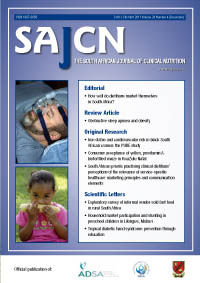Consumer acceptance of yellow, provitamin A-biofortified maize in KwaZulu-Natal
Keywords:
yellow maize, provitamin A, vitamin A deficiency, consumer acceptance
Abstract
Objectives: To assess the acceptance of popular maize food products (phutu, thin porridge and samp), prepared with yellow, provitamin A-biofortified maize varieties, in 212 subjects between the ages of three and 55 years, from rural KwaZulu-Natal. Design: A cross-sectional study. Method: Preschool, primary school and secondary school subjects were randomly selected from two primary schools and one secondary school, respectively, while adult subjects constituted a convenience sample. Pre- and primary school children completed a paired preference test. Secondary school and adult subjects completed a five-point facial hedonic and a preference ranking test. Focus group discussions were conducted using adult subjects. Results: Preschool children preferred yellow maize to white maize food products: phutu (81% vs. 19%; p-value < 0.001), thin porridge (75% vs. 25%; p-value < 0.001) and samp (73% vs. 27%; p-value < 0.001). There was no statistically significant difference in preference for white and yellow maize by primary school children. Secondary school and adult subjects preferred white maize to yellow maize. Focus group discussions confirmed the preference for white maize by the adults. Conclusion: The study findings suggest that yellow, provitamin A-biofortified maize has the potential to succeed as a new strategy of dealing with the serious problem of vitamin A deficiency, especially among children of preschool age. However, in older groups, this strategy is unlikely to be successful, unless other strategies are implemented, including intensive nutrition education programmes on the nutritional benefits of the maize, targeting the market price at which yellow maize is sold, increasing its availability in local grocery stores, and improving its sensory properties through breeding.
Published
2011-10-09
How to Cite
Pillay, K., Siwela, M., Derera, J., & Veldman, F. (2011). Consumer acceptance of yellow, provitamin A-biofortified maize in KwaZulu-Natal. South African Journal of Clinical Nutrition, 24(4), 186-191. Retrieved from http://sajcn.co.za/index.php/SAJCN/article/view/531
Issue
Section
Original Research
Material submitted for publication in the South African Journal of Clinical Nutrition (SAJCN) is accepted provided it has not been published elsewhere. Copyright forms will be sent with acknowledgement of receipt and the SAJCN reserves copyright of the material published.
The SAJCN does not hold itself responsible for statements made by the authors.


